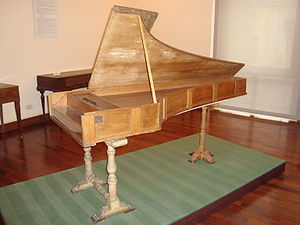Bartolomeo Cristofori di Francesco (May 4, 1655 – January 27, 1731) was an Italian maker of musical instruments, generally regarded as the inventor of the piano.

The available source materials on Cristofori's life include his birth and death records, two wills, the bills he submitted to his employers, and a single interview done by Scipione Maffei. From the latter, both Maffei's notes and the published journal article are preserved.
Cristofori was born in Padua in the Republic of Venice. Nothing is known of his early life. A tale is told that he served as an apprentice to the great violin maker Nicolò Amati, based on the appearance in a 1680 census record of a "Christofaro Bartolomei" living in Amati's house in Cremona. However, as Stewart Pollens points out (see References below), this person cannot be Bartolomeo Cristofori, since the census records an age of 13, whereas Cristofori according to his baptismal record would have been 25 at the time. Pollens also doubts the authenticity of the cello and double bass instruments sometimes attributed to Cristofori.
Probably the most important event in Cristofori's life is the first one of which we have any record: in 1688, at age 33, he was recruited to work for Prince Ferdinando de Medici. Ferdinando, a lover and patron of music, was the son and heir of Cosimo III, Grand Duke of Tuscany. Tuscany was at a time still a small independent state.
It is not known what led Ferdinando to recruit Cristofori. The Prince traveled to Venice in 1688 to attend the Carnival, so he may have met Cristofori passing through Padua on his way home. Ferdinando was looking for a new technician to take care of his many musical instruments, the previous incumbent having just died. However, it seems possible that the Prince wanted to hire Cristofori not just as his technician, but specifically as an innovator in musical instruments. It would be surprising if Cristofori at age 33 had not already shown the inventiveness for which he later became famous.
The evidence—all circumstantial—that Cristofori may have been hired as an inventor is as follows. According to Stewart Pollens, there were already a number of qualified individuals in Florence who could have filled the position; however, the Prince passed them over, and paid Cristofori a higher salary than his predecessor. Moreover, Pollens notes, "curiously, [among the many bills Cristofori submitted to his employer] there are no records of bills submitted for Cristofori's pianofortes ... This could mean that Cristofori was expected to turn over the fruits of his experimentation to the court." Lastly, the Prince was evidently fascinated with machines (he collected over forty clocks, in addition to a great variety of elaborate musical instruments), and would thus be naturally interested in the elaborate mechanical action that was at the core of Cristofori's work on the piano.
Maffei's interview reports Cristofori's memory of his conversation with the Prince at this time:
che fu detto al Principe, che non volevo; rispos' egli il farò volere io.
which Giuliana Montanari (reference below) translates as:
The prince was told that I did not wish to go; he replied that he would make me want to
This suggests that the Prince may have felt that Cristofori would be a prize recruit and was trying to charm him into accepting his offer; consistent again with the view that the Prince was attempting to recruit him as an inventor.
In any event, Cristofori agreed to the appointment, for a salary of 12 scudi per month. He moved rather quickly to Florence (May 1688; his job interview having taken place in March or April), was issued a house, complete with utensils and equipment, by the Grand Duke's administration, and set to work. For the Prince, he tuned, maintained, and transported instruments; worked on his various inventions, and also did restoration work on valuable older harpsichords.[1]
At this time, the Grand Dukes of Tuscany employed a large staff of about 100 artisans, who worked in the Galleria dei Lavori of the Uffizi. Cristofori's initial work space was probably in this area, which did not please him. He later told Maffei:
che da principio durava fatica ad andare nello stanzone in questo strepito
It was hard for me to have to go into the big room with all that noise (tr. Montanari)
Cristofori did eventually obtain his own workshop, usually keeping one or two assistants working for him.
Cristofori's pianos
The total number of pianos built by Cristofori is unknown. Only three survive today, all dating from the 1720s. A 1720 instrument is located in the Metropolitan Museum in New York. This instrument has been extensively altered by later builders: the soundboard was replaced in 1938, and the 54-note range was shifted by about half an octave, from F', G', A'–c''' to C–f''. Although this piano is playable, according to builder Denzil Wraight "its original condition ... has been irretrievably lost," and it can provide no indication of what it sounded like when new.[7] A 1722 instrument is in the Museo Nazionale degli Strumenti Musicali in Rome. It has a range of four octaves (C-c³) and includes an "una corda" stop; see below. This piano has been damaged by worms and is not playable.[7] A 1726 instrument is in the Musikinstrumenten-Museum of Leipzig University. Four octaves (C-c³) with "una corda" stop. This instrument is not currently playable, though in the past recordings were made.[7] The three surviving instruments all bear essentially the same Latin inscription: BARTHOLOMAEVS DE CHRISTOPHORIS PATAVINUS INVENTOR FACIEBAT FLORENTIAE [date] where the date is rendered in Roman numerals. The meaning is "Bartolomeo Cristofori of Padua, inventor, made [this] in Florence in [date]."
 |
